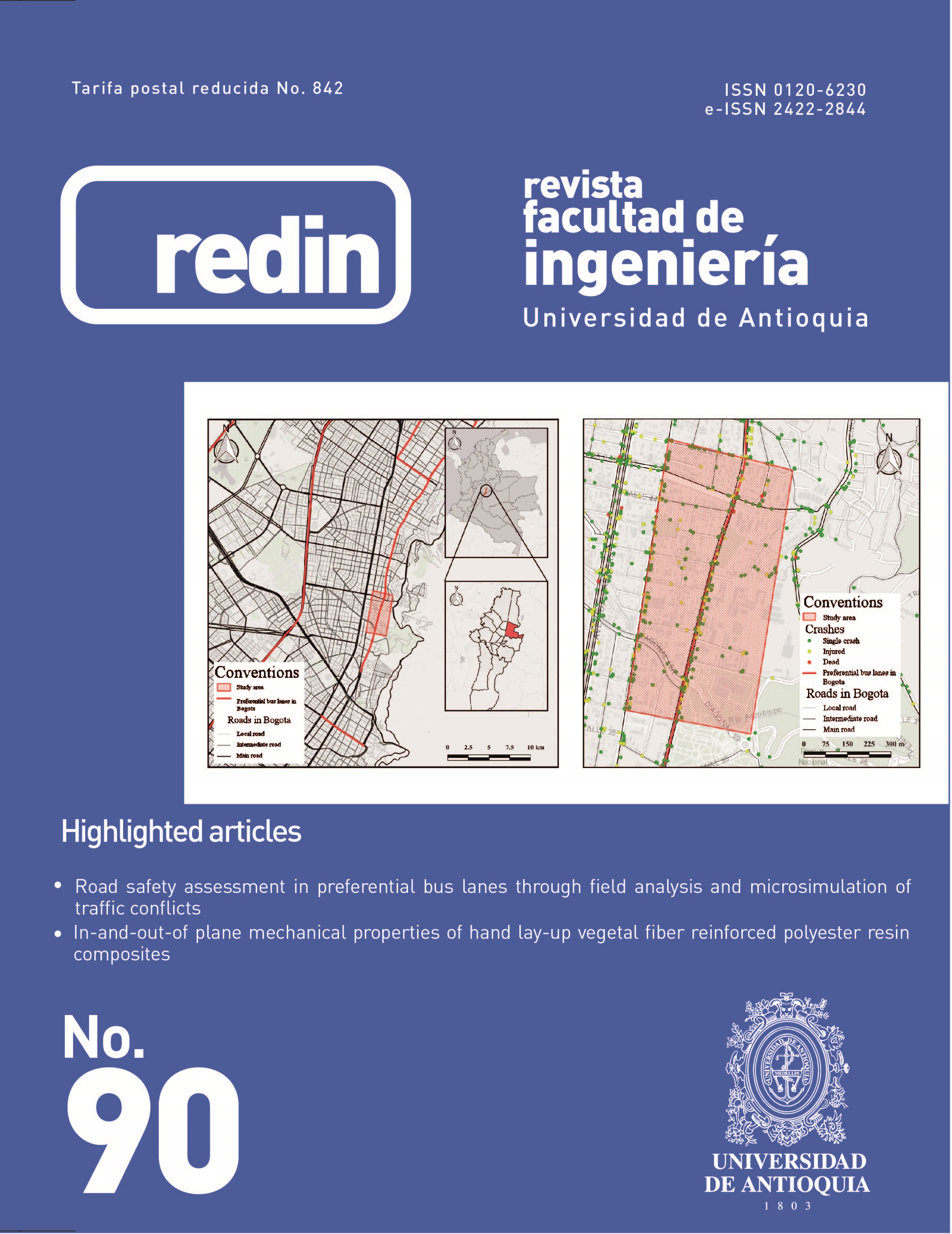Evaluación del desempeño de un modelo a escala del tanque de alta tasa de sedimentación en el tratamiento de agua potable
DOI:
https://doi.org/10.17533/udea.redin.n90a02Palabras clave:
manto de flóculos, AguaClara, velocidad deflujo ascendente, láminas de sedimentaciónResumen
El programa AguaClara de la Universidad de Cornell ha investigado formas de mejorar el proceso de tratamiento de aguas a bajo costo y sin depender de fuentes energía adicionales. En este proyecto fue investigado un proceso basado en la Sedimentación de Alta Tasa (HRS, por sus siglas en inglés), el cual presenta un flujo vertical y menor área con respecto a tanques tradicionales. El objetivo consiste en analizar los parámetros que pueden afectar el desempeño del tanque HRS incluyendo velocidad, densidad del manto de flóculos y ubicación de las láminas de sedimentación en un modelo de tanque de sedimentación de alta tasa a escala de laboratorio. Diferentes velocidades fueron evaluadas y el desempeño del manto de flóculos fue estudiado a través de mediciones continuas de turbidez del agua. Los resultados demostraron que el tanque de alta tasa permite la generación del manto de flóculos y, cuenta con un diseño versátil y accesible. Adicionalmente, el desempeño del tanque de sedimentación mejora a bajas velocidades; sin embargo, este estudio sugiere que el uso de láminas de sedimentación en la parte superior del tanque permite estabilizar el manto de flóculos a velocidades mayores, debido a la función desempeñada en la formación de flóculos más densos.
Descargas
Citas
M. W. Hurst, “Evaluation of parameters affecting steady-state floc blanket performance,” M.S. thesis, Cornell University, Ithaca, New York, 2010.
M. J. Rhodes, Introduction to Particle Technology. England, UK: John Wiley & Sons, 2008.
C. R. Schulz and D. A. Okun, Surface Water Treatment for Communities in Developing Countries. New York, U.S.A: John Wiley & Sons, 1984.
G. Tchobanoglous and E. D. Schroeder, Water Quality. Boston, U.S.A.: Addison-Wesley Publishing Company Inc, 1987.
R. S. Al-Kizwini, “Improvement of sedimentation process using inclined plates,” Mesopotamia Environmental Journal, vol. 2, no. 1, pp. 100–114, 2015.
G. Zhu, Y. Zhang, J. Ren, T. Qiu, and T. Wang, “Flow simulation and analysis in a vertical-flow sedimentation tank,” Energy Procedia, vol. 16, pp. 197–202, 2012.
R. Gregory, R. J. M. Head, and N. J. D. Graham, “The relevance of blanket solids concentration in understanding the performance of floc blanket clarifiers in water treatment,” in Chemical Water and Wastewater Treatment IV, Edinburgh, Scotland, 1996, pp. 17–29.
M. Hurst, M. Weber, and L. W. Lion, “Image analysis of floc blanket dynamics: Investigation of floc blanket thickening, growth, and steady state,” Journal of environmental engineering, vol. 140, no. 4, Apr. 2014.
O. Anyene and et al., “High rate sedimentation- floc blanket,” Research group Civil and Environmental Engineering, Cornell University, Ithaca, New York, U.S.A, Tech. Rep., Jun. 2016.
Y. Yu, L. Zhu, A. Cheng, and S. Lok, “High rate sedimentation plate settlers,” Cornell University, Ithaca, New York, Tech. Rep., Jun. 2016.
A. I. Salem, “On fluid dynamics of lamella separator modelling and process optimization,” M.S. thesis, Universität Bremen, Bremen, Germany, 2012.
R. Tarpagkou and A. Pantokratoras, “The influence of lamellar settler in sedimentation tanks for potable water treatment — a computational fluid dynamic study,” Powder Technology, vol. 268, pp. 139–149, Dec. 2014.
Descargas
Publicado
Cómo citar
Número
Sección
Licencia
Derechos de autor 2019 Revista Facultad de Ingeniería Universidad de Antioquia

Esta obra está bajo una licencia internacional Creative Commons Atribución-NoComercial-CompartirIgual 4.0.
Los artículos disponibles en la Revista Facultad de Ingeniería, Universidad de Antioquia están bajo la licencia Creative Commons Attribution BY-NC-SA 4.0.
Eres libre de:
Compartir — copiar y redistribuir el material en cualquier medio o formato
Adaptar : remezclar, transformar y construir sobre el material.
Bajo los siguientes términos:
Reconocimiento : debe otorgar el crédito correspondiente , proporcionar un enlace a la licencia e indicar si se realizaron cambios . Puede hacerlo de cualquier manera razonable, pero no de ninguna manera que sugiera que el licenciante lo respalda a usted o su uso.
No comercial : no puede utilizar el material con fines comerciales .
Compartir igual : si remezcla, transforma o construye a partir del material, debe distribuir sus contribuciones bajo la misma licencia que el original.
El material publicado por la revista puede ser distribuido, copiado y exhibido por terceros si se dan los respectivos créditos a la revista, sin ningún costo. No se puede obtener ningún beneficio comercial y las obras derivadas tienen que estar bajo los mismos términos de licencia que el trabajo original.










 Twitter
Twitter